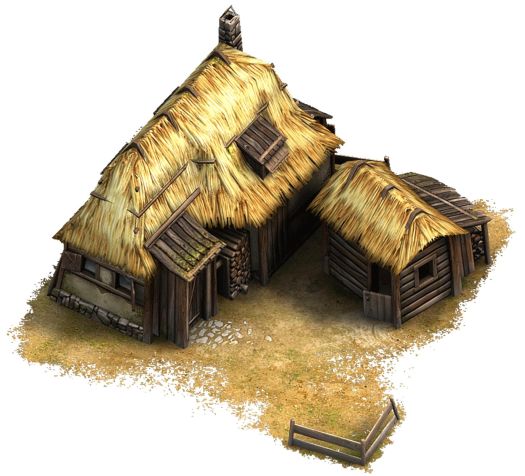Borderland Farms (RWG)
Borderland farms are randomly generated 6-mile hex settings where the environment reflects a balance between cultivated farmland and the surrounding wilderness. The farms, typically small homesteads, have ploughed between 15 and 30 acres of land for crops, while the surrounding hinterland is utilised for game and foraging, and rarely woodcutting. Each farmstead is usually a modest hovel, with 1 in 4 including a barn, with each situated along a waterway, whether a river, stream or creek. If a river or stream has insufficient length to accommodate the number of farms indicated, a creek needs to be invented which the remaining farms would follow. Randomly determine the location of the first "domain hex" from which the remaining farms proliferate.
Contents
Farms are spaced approximately three-quarters of a mile apart, housing between 3 and 6x persons. In total, there are between 12 and 18 farms within each 6-mile hex, connected by footpaths to a nearby village in a civilised hex. Some footpaths may evolve into better routes depending on the terrain and usage.
Residents
The occupants of these farms are typically commoners, possessing the sage abilities necessary for survival in their rural lifestyle, yet they are non-levelled individuals. They rely on bartering their produce, such as fruits, cereals or vegetables, with outsiders. Hospitality is a valued trait among them, and they are often willing to offer one day's worth of food and a night's stay in their barn for a minimal fee, usually a single copper piece per person. This practice demonstrates their community spirit and readiness to support travellers.
Among these commoners, 1 in 6, usually the head of the farm, is considered hardened, indicating a stronger or more resilient individual. If an adventuring party seeks to recruit someone for a task, there is a slim chance — only 4% per farm — that a hardened individual, a brother or eldest descendant, would be interested in leaving home upon an adventure. If such a person exists, the likelihood of them being levelled is a mere 6%, and even then, they must be counted as 1st level, having recently completed their training before returning to their familial duties.
These borderland farms represent a community deeply intertwined with the land, where survival depends on both agricultural skills and the ability to make use of the surrounding wilderness. The interactions with outsiders are characterized by modest trade and generous hospitality, reflecting a simple yet resilient way of life.
Happenstance
| roll | result |
|---|---|
| 01 | disease |
| 02-03 | expedition |
| 04-06 | external meddling |
| 07-10 | fortunate hunt |
| 11-12 | friend |
| 13-17 | lost livestock |
| 18 | monster |
| 19-23 | new settler |
| 24-28 | offer of work |
| 29 | orphan/lost child |
| 30 | outlaws/bandits |
| 31-33 | predator |
| 34-39 | predator sighting |
| 40-44 | quarrel |
| 45-47 | raising |
| 48-49 | runaway slave/serf |
| 50-55 | vermin |
| 56-00 | no result |
In this setting, "happenstance" refers to the news and circumstances affecting the lives of these peasant farmers. These events become known when the players meaningfully interact within the farmer's society, whether by staying overnight, sharing a meal, or taking on work for a few days in exchange for food. Results reflect local gossip or knowledge of ongoing or upcoming events, or possibly the arrival of news about something that's just occurred. If the party should choose to search or wander parts of the hex without farms, see "Wandering" below. This same table is used regardless of the vegetation or terrain relief.
